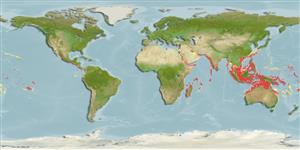Environment: milieu / climate zone / depth range / distribution range
Ecology
Marine; demersal; non-migratory; depth range 15 - 95 m (Ref. 30573). Tropical
Indo-West Pacific: Red Sea, Madagascar and Gulf of Oman; northern Indian Ocean; Indonesia, Gulf of Thailand, Philippines, Papua New Guinea, the Arafura Sea (Ref. 9819), northwest shelf of Australia and New Caledonia. Recently reported from Tonga (Ref. 53797).
Size / Weight / Age
Maturity: Lm ? range ? - ? cm
Max length : 50.0 cm TL male/unsexed; (Ref. 1623); common length : 15.0 cm TL male/unsexed; (Ref. 9790)
Dorsal spines (total): 9; Dorsal soft rays (total): 10 - 12; Anal spines: 0; Anal soft rays: 10 - 12. Lower edge of preopercle projecting downward as a strong antrorse spine. Infraorbital and suborbital ridges bearing many fine serrations. Lower side of head unicarinate. Dorsal fin usually 11. Iris lappet bilobed. Caudal fin with a white basal band, a broad dusky submarginal band and a narrow white edge.
Body shape (shape guide): elongated.
Benthic on sand and mud bottoms (Ref. 30573). Usually caught with trawls to depths of about 80 m (Ref 90102).
Life cycle and mating behavior
Maturity | Reproduction | Spawning | Eggs | Fecundity | Larvae
Knapp, L.W., 1999. Platycephalidae. Flatheads. p. 2385-2421. In K.E. Carpenter and V.H. Niem (eds.) FAO species identification guide for fishery purposes. The living marine resources of the Western Central Pacific. Volume 4. Bony fishes part 2 (Mugilidae to Carangidae). FAO, Rome. (Ref. 9790)
IUCN Red List Status (Ref. 130435: Version 2025-1)
Threat to humans
Harmless
Human uses
Tools
Special reports
Download XML
Internet sources
Estimates based on models
Preferred temperature (Ref.
123201): 24.5 - 28.6, mean 27.5 °C (based on 655 cells).
Phylogenetic diversity index (Ref.
82804): PD
50 = 0.5078 [Uniqueness, from 0.5 = low to 2.0 = high].
Bayesian length-weight: a=0.00457 (0.00230 - 0.00908), b=3.09 (2.91 - 3.27), in cm total length, based on LWR estimates for this (Sub)family-body shape (Ref.
93245).
Trophic level (Ref.
69278): 3.9 ±0.7 se; based on size and trophs of closest relatives
Resilience (Ref.
120179): Medium, minimum population doubling time 1.4 - 4.4 years (Preliminary K or Fecundity.).
Fishing Vulnerability (Ref.
59153): Moderate vulnerability (40 of 100).
🛈
